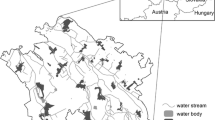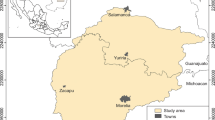Abstract
Improving our knowledge of pre-anthropogenic landscapes is vital for understanding landscape-scale heterogeneity and for setting goals and objectives for ecological restoration. This is especially important in highly modified landscapes that contain few remnants of pre-impact ecosystems. This study aims to develop new methodology to improve understanding of historical vegetation, using the now-degraded inhabited highlands of the Galapagos Islands as a case study. Our multidisciplinary approach innovatively combines data from interviews with residents who were familiar with the vegetation before most degradation occurred with the more traditional sources of historical aerial photography and information from early explorer and scientist reports. We reconstruct historical vegetation across the landscape by mapping it in the year 1960 and discussing this map in the historical context of anthropogenic change. Our results confirm published vegetation types but also define some other types not previously described, and suggest much greater spatial, temporal and structural heterogeneity than commonly understood. This result can be used by Galapagos land managers to better match species assemblages with sites and plan restoration actions that will maximise resilience against the ongoing and future threats of climate change and species invasions. Our methodology can be applied in extensive areas of the world where the majority of anthropogenic disturbance to natural ecosystems has been within the past 60 years.




Similar content being viewed by others
References
Arce-Nazario JA (2007) Human landscapes have complex trajectories: reconstructing Peruvian Amazon landscape history from 1948 to 2005. Landscape Ecol 22:89–101
Bell SS, Fonseca MS, Motten LB (1997) Linking restoration and landscape ecology. Restor Ecol 5(4):318–323
Bensted-Smith R, Powell G, Dinerstein E (2002) Planning for the ecoregion. In: Bensted-Smith R (ed) A biodiversity vision for the Galapagos Islands. Charles Darwin Foundation and World Wildlife Fund, Puerto Ayora
Bowman RI (1961) Morphological differentiation and adaptation in the Galapagos. University of California publications in zoology, Finches
Bush M, Colinvaux PA, Steinitz-Kannan M, Overpeck JT, Sachs J, Cole JE, Collins A, Conroy JL, Restrepo A, Zhang Z (2010) Forty years of paleoecology in the Galapagos. Galapagos Res 67:55–61
Butzer KW, Helgren DM (2005) Livestock, land cover, and environmental history: the tablelands of New South Wales, Australia, 1820–1920. Ann Assoc Am Geogr 95(1):80–111
Colinvaux P, Schofield E (1976) Historical ecology in the Galapagos Islands. II. A Holocene spore record from El Junco Lake, Isla San Cristobal. J Ecol 64:1013–1028
Domon G, Bouchard A (2007) The landscape history of Godmanchester (Quebec, Canada): two centuries of shifting relationships between anthropic and biophysical factors. Landscape Ecol 22:1201–1214
Duncan DH, Kyle G, Race D (2010) Combining facilitated dialogue and spatial data analysis to compile landscape history. Environ Conserv 37(4):432–441
Edmonds M (2005) The pleasures and pitfalls of written records. In: Egan D, Howell EA (eds) The historical ecology handbook: a restorationist’s guide to reference ecosystems, 2nd edn. Society for Ecological Restoration International, Washington, DC, pp 73–99
Egan D, Howell EA (2005) The historical ecology handbook: A restorationist’s guide to reference ecosystems, 2nd edn. Society for Ecological Restoration International, Washington, DC
Eliasson U (1982) Changes and constancy in the vegetation of the Galapagos Islands. Noticias de Galápagos 36:7–12
Epler B (2007) Tourism, the Economy and Population Growth and Conservation in Galapagos. Charles Darwin Foundation, Puerto Ayora
Fairhead J, Leach M (1996) Misreading the African landscape: Society and ecology in a forest-savanna mosaic. Cambridge University Press, UK
Fensham RJ (1989) The pre-European vegetation of the Midlands, Tasmania: a floristic and historical analysis of vegetation patterns. J Biogeogr 16(1):29–45
Fensham RJ, Fairfax RJ (2003) A land management history for central Queensland, Australia as determined from land-holder questionnaire and aerial photography. J Environ Manage 68(4):409–420
Fogerty JE (2005) Oral history: a guide to its creation and use. In: Egan D, Howell EA (eds) The historical ecology handbook: a restorationist’s guide to reference ecosystems, 2nd edn. Society for Ecological Restoration International, Washington, DC, pp 101–120
Fundación Jatun Sacha (2012) Galapagos reserve. http://jatunsacha.org/ingles/portada.php?id=5. Accessed 8 June 2012
Fundar Galapagos (2012) Fundar Galapagos activities. http://www.fundargalapagos.org/portalj/files/FundarVOLUNTEERS/FUNDAR%20-%20Volunteer%20Activities%20English%202012.pdf. Accessed 8 June 2012
García G, Gardener MR (2011) Evaluación de proyectos de control de plantas transformadores y reforestación de sitios de alta valor en Galápagos (Project evaluation of transformer plant controls and reforestation of high value sites in Galapagos). Dirección del Parque Nacional Galápagos y Fundación Charles Darwin, Puerto Ayora
Gardener MR, Atkinson R, Rentería JL (2010) Eradications and people: lessons from the plant eradication program in Galapagos. Restor Ecol 18(1):20–29
Grossinger RM, Striplen CJ, Askevold RA, Brewster E, Beller EE (2007) Historical landscape ecology of an urbanized California valley: wetlands and woodlands in the Santa Clara Valley. Landscape Ecol 22:103–120
Guézou A, Trueman M, Buddenhagen CE, Chamorro S, Guerrero AM, Pozo P, Atkinson R (2010) An extensive alien plant inventory from the inhabited areas of Galapagos. PLoS One 5(4):e10276
Hamann O (1975) Vegetational changes in the Galápagos Islands during the period 1966–1973. Biol Conserv 7:37–59
Hamann O (1981) Plant communities of the Galápagos Islands. Dansk Botanisk Arkiv 34(2):1–163
Hamann O (2001) Demographic studies of three indigenous stand-forming plant taxa (Scalesia, Opuntia, and Bursera) in the Galápagos Islands, Ecuador. Biodivers Conserv 110(2):223–250
Howell JT (1942) Up under the equator: first ascent of Mt Crocker in 1832 (May 9) as part of the Templeton Crocker Expedition of the California Academy of Sciences. Sierra Club Bulletin 27:79–82
Huttel C (1995) Vegetación en coladas de lava (Vegetation on lava flows). ORSTOM y Fundacion Charles Darwin, Quito
INGALA, PRONAREG, ORSTOM (1989) Inventario cartográfico de los recursos naturales, geomorfología, vegetación, hídricos, ecológicos y biofísicos de las Islas Galápagos, Ecuador 1:100,000 (Cartographic inventory of natural resources, geomorphology, vegetation, hydrology, ecology and biophysics of the Galapagos Islands, Ecuador). INGALA, Quito
Itow S (1971) A study of vegetation on Isla Santa Cruz, Galapagos Islands. Noticias de Galapagos 17:10–13
Itow S (1995) Phytogeography and ecology of Scalesia (Compositae) endemic to the Galápagos Islands. Pac Sci 49(1):17–30
Jackson ST, Hobbs RJ (2009) Ecological restoration in the light of ecological history. Science 325(5940):567–569
Jaramillo P, Guézou A (2012) CDF Checklist of Galapagos Vascular Plants–FCD Lista de especies de Plantas Vasculares de Galápagos. Charles Darwin Foundation. http://www.darwinfoundation.org/datazone/checklists/vascular-plants/. Accessed 14 September 2012
Kastdalen A (1982) Changes in the biology of Santa Cruz Island between 1935 and 1965. Noticias de Galápagos 35:7–12
Keith DA, Martin TG, McDonald-Madden E, Walters C (2011) Uncertainty and adaptive management for biodiversity conservation. Biol Conserv 144(4):1175–1178
Knott T, Lunney D, Coburn D, Callaghan J (1998) An ecological history of koala habitat in Port Stephens Shire and the Lower Hunter on the central coast of New South Wales, 1801–1998. Pac Conserv Biol 4(4):354–368
Lawesson JE (1988) Stand-level dieback and regeneration of forests in the Galápagos Islands. Vegetatio 77:87–93
Lechner AM, Langford WT, Bekessy SA, Jones SD (2012) Are landscape ecologists addressing uncertainty in their remote sensing data? Landscape Ecol, 27(9):1249–1261
Lillesand TM, Kiefer RW, Chipman JW (2008) Remote sensing and image interpretation, 6th edn. John Wiley & Sons, Inc., Hoboken
Lundh JP (2006) The farm area and cultivated plants on Santa Cruz, 1932–1965, with remarks on other parts of Galapagos. Galapagos Res 64:12–25
Mabberley DJ (1997) The plant-book: a portable dictionary of the vascular plants, 2nd edn. Cambridge University Press, Cambridge
Morgan JL, Gergel SE, Coops NC (2010) Aerial photography: a rapidly evolving tool for ecological management. Bioscience 60(1):47–59
Mueller-Dombois D, Fosberg FR (1998) Vegetation of the tropical Pacific Islands. Springer, New York
Porter DM (1984) Endemism and evolution in terrestrial plants. In: Perry R (ed) Galapagos. Key environments. Pergamon Press, Oxford, pp 85–100
Regan HM, Ben-Haim Y, Langford B, Wilson WG, Lundberg P, Andelman SJ, Burgman MA (2005) Robust decision-making under severe uncertainty for conservation management. Ecol Appl 15(4):1471–1477
Rentería JL (2011) Towards an optimal management of the invasive plant Rubus niveus in the Galapagos Islands. PhD thesis, Imperial College, London, UK
Restrepo A, Colinvaux P, Bush M, Correa-Metrio A, Conroy J, Gardener MR, Jaramillo P, Steinitz-Kannan M, Overpeck J (2012) Impacts of climate variability and human colonization on the vegetation of the Galápagos Islands. Ecology 93(8):1853–1866
Rhemtulla JM, Hall RJ, Higgs ES, Macdonald SE (2002) Eighty years of change: vegetation in the montane ecoregion of Jasper National Park, Alberta, Canada. Can J For Res 32:2010–2021
Ritchie DA (2003) Doing oral history: a practical guide, 2nd edn. Oxford University Press, USA
Robertson HA, McGee TK (2003) Applying local knowledge: the contribution of oral history to wetland rehabilitation at Kanyapella Basin, Australia. J Environ Manage 69(3):275–287
Sachs J, Ladd SN (2010) Expected changes in the climate and oceanography of the Galapagos in the 21st century. Galapagos Res 67:50–54
SER (Society for Ecological Restoration International Science & Policy Working Group) (2004) The SER International Primer on Ecological Restoration. Society for Ecological Restoration International. http://www.ser.org/pdf/primer3.pdf Accessed 18 October 2012
Skaloš J, Weber M, Lipský Z, Trpáková I, Šantrůčková M, Uhlířová L, Kukla P (2011) Using old military survey maps and orthophotograph maps to analyse long-term land cover changes—Case study (Czech Republic). Appl Geogr 31(2):426–438
Snell H, Rea S (1999) The 1997–1998 El Niño in Galápagos: can 34 years of data estimate 120 years of pattern? Noticias de Galápagos 60:11–20
Steinitz-Kannan M, Riedinger M, Last W, Brenner M, Miller M (1999) A six thousand year history of El Niño events in the Galápagos: evidence from lake cores. Proc Am Assoc Adv Sci, Pac Div 18(1):84
Stewart A (1911) A botanical survey of the Galapagos Islands. Proc Calif Acad Sci 1:7–288
Trueman M, d’Ozouville N (2010) Characterizing the Galapagos terrestrial climate in the face of global climate change. Galapagos Res 67:26–37
Trueman M, Atkinson R, Guézou A, Wurm P (2010) Residence time and human-mediated propagule pressure at work in the alien flora of Galapagos. Biol Invasions 12(12):3949–3960
Tucker G, Fasham M, Hill D, Shewry M, Shaw P, Wade M (2005) Planning a programme. In: Hill D, Fasham M, Tucker G, Shewry M, Shaw P (eds) Handbook of biodiversity methods: Survey, evaluation and monitoring. Cambridge, Cambridge, pp 6–64
Tye A, Snell HL, Peck SB, Andersen H (2002) Outstanding terrestrial features of the Galapagos archipelago, Chapter 3. In: Bensted-Smith R (ed) A biodiversity vision for the Galapagos Islands. Charles Darwin Foundation and World Wildlife Fund, Puerto Ayora, pp 12–23
van der Werff H (1978) The vegetation of the Galápagos Islands. PhD thesis, University of Utrecht, Utrecht, Netherlands
Walsh SJ, McCleary AL, Heumann BW, Brewington L, Raczkowski EJ, Mena CF (2010) Community expansion and infrastructure development: implications for human health and environmental quality in the Galápagos Islands of Ecuador. J Lat Am Geogr 9(3):137–159
Watson J, Trueman M, Tufet M, Henderson S, Atkinson R (2009) Mapping terrestrial anthropogenic degradation on the inhabited islands of the Galápagos archipelago. Oryx 44(1):79–82
White PS, Walker JL (1997) Approximating nature’s variation: selecting and using reference information in restoration ecology. Restor Ecol 5(4):338–349
Wiggins IL, Porter DM (1971) Flora of the Galapagos Islands. Stanford University Press, Stanford
Acknowledgments
We are indebted to the long-term residents of Santa Cruz Island for so openly sharing their memories, and many other Galapagos residents for helping us to find these people. Thanks to Mark R. Gardener and Anne Guézou for encouraging the interviews and for comments on a draft of this manuscript. Postgraduate research funding and a scholarship from the University of Western Australia enabled this work, along with a donation from the Belgian Science Policy Office. This publication is contribution number 2056 of the Charles Darwin Foundation for the Galapagos Islands.
Author information
Authors and Affiliations
Corresponding author
Electronic supplementary material
Below is the link to the electronic supplementary material.
Rights and permissions
About this article
Cite this article
Trueman, M., Hobbs, R.J. & Van Niel, K. Interdisciplinary historical vegetation mapping for ecological restoration in Galapagos. Landscape Ecol 28, 519–532 (2013). https://doi.org/10.1007/s10980-013-9854-4
Received:
Accepted:
Published:
Issue Date:
DOI: https://doi.org/10.1007/s10980-013-9854-4




